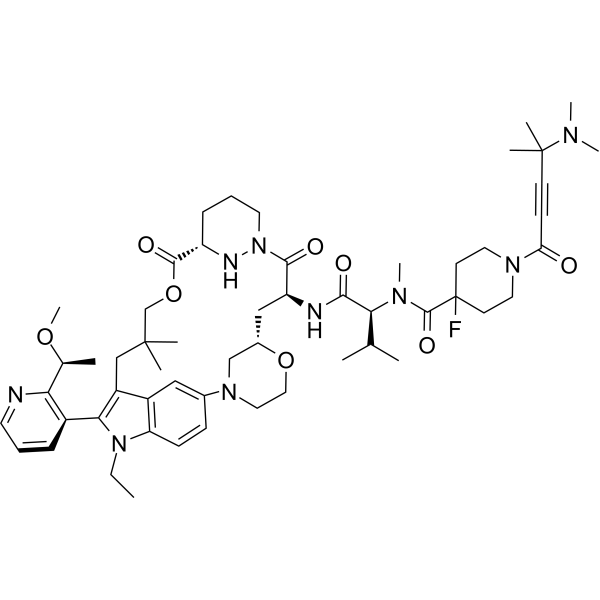Physicochemical Properties
| Molecular Formula | C55H78FN9O8 |
| Exact Mass | 1011.6 |
| Elemental Analysis | C, 65.26; H, 7.77; F, 1.88; N, 12.45; O, 12.64 |
| CAS # | 2641998-63-0 |
| Related CAS # | 2641998-63-0 |
| PubChem CID | 156336120 |
| Appearance | White to off-white solid |
| LogP | 5.6 |
| Hydrogen Bond Donor Count | 2 |
| Hydrogen Bond Acceptor Count | 13 |
| Rotatable Bond Count | 11 |
| Heavy Atom Count | 73 |
| Complexity | 2040 |
| Defined Atom Stereocenter Count | 5 |
| SMILES | CCN1C2=C3C=C(C=C2)N4CCO[C@H](C4)C[C@@H](C(=O)N5CCC[C@H](N5)C(=O)OCC(CC3=C1C6=C(N=CC=C6)[C@H](C)OC)(C)C)NC(=O)[C@H](C(C)C)N(C)C(=O)C7(CCN(CC7)C(=O)C#CC(C)(C)N(C)C)F |
| InChi Key | HJNFYLSFWYRSHS-CMZSUCOPSA-N |
| InChi Code | InChI=1S/C55H78FN9O8/c1-13-64-44-19-18-37-30-40(44)41(48(64)39-16-14-24-57-46(39)36(4)71-12)32-53(5,6)34-73-51(69)42-17-15-25-65(59-42)50(68)43(31-38-33-63(37)28-29-72-38)58-49(67)47(35(2)3)61(11)52(70)55(56)22-26-62(27-23-55)45(66)20-21-54(7,8)60(9)10/h14,16,18-19,24,30,35-36,38,42-43,47,59H,13,15,17,22-23,25-29,31-34H2,1-12H3,(H,58,67)/t36-,38-,42-,43-,47-/m0/s1 |
| Chemical Name | 1-[4-(dimethylamino)-4-methylpent-2-ynoyl]-N-[(2S)-1-[[(6S,8S,14S)-22-ethyl-21-[2-[(1S)-1-methoxyethyl]pyridin-3-yl]-18,18-dimethyl-9,15-dioxo-5,16-dioxa-2,10,22,28-tetrazapentacyclo[18.5.2.12,6.110,14.023,27]nonacosa-1(26),20,23(27),24-tetraen-8-yl]amino]-3-methyl-1-oxobutan-2-yl]-4-fluoro-N-methylpiperidine-4-carboxamide |
| Synonyms | GTPL12622; RMC-6291; RMC-6291; RMC-6291 |
| HS Tariff Code | 2934.99.9001 |
| Storage |
Powder-20°C 3 years 4°C 2 years In solvent -80°C 6 months -20°C 1 month |
| Shipping Condition | Room temperature (This product is stable at ambient temperature for a few days during ordinary shipping and time spent in Customs) |
Biological Activity
| Targets | Cereblon; SOS1 |
| References |
[1]. RMC-6291, a next-generation tri-complex KRASG12C (ON) inhibitor, outperforms KRASG12C (OFF) inhibitors in preclinical models of KRASG12C cancers[J]. Cancer Research, 2022, 82(12_Supplement): 3595-3595. |
Solubility Data
| Solubility (In Vitro) | DMSO : ~100 mg/mL (~98.79 mM) |
| Solubility (In Vivo) |
Solubility in Formulation 1: 2.5 mg/mL (2.47 mM) in 10% DMSO + 40% PEG300 + 5% Tween80 + 45% Saline (add these co-solvents sequentially from left to right, and one by one), suspension solution; with sonication. For example, if 1 mL of working solution is to be prepared, you can add 100 μL of 25.0 mg/mL clear DMSO stock solution to 400 μL PEG300 and mix evenly; then add 50 μL Tween-80 to the above solution and mix evenly; then add 450 μL normal saline to adjust the volume to 1 mL. Preparation of saline: Dissolve 0.9 g of sodium chloride in 100 mL ddH₂ O to obtain a clear solution. Solubility in Formulation 2: 2.5 mg/mL (2.47 mM) in 10% DMSO + 90% (20% SBE-β-CD in Saline) (add these co-solvents sequentially from left to right, and one by one), suspension solution; with ultrasonication. For example, if 1 mL of working solution is to be prepared, you can add 100 μL of 25.0 mg/mL clear DMSO stock solution to 900 μL of 20% SBE-β-CD physiological saline solution and mix evenly. Preparation of 20% SBE-β-CD in Saline (4°C,1 week): Dissolve 2 g SBE-β-CD in 10 mL saline to obtain a clear solution. Solubility in Formulation 3: ≥ 2.5 mg/mL (2.47 mM) (saturation unknown) in 10% DMSO + 90% Corn Oil (add these co-solvents sequentially from left to right, and one by one), clear solution. For example, if 1 mL of working solution is to be prepared, you can add 100 μL of 25.0 mg/mL clear DMSO stock solution to 900 μL of corn oil and mix evenly. (Please use freshly prepared in vivo formulations for optimal results.) |
